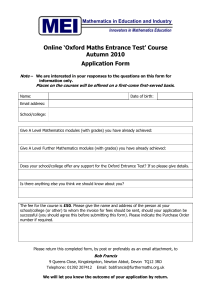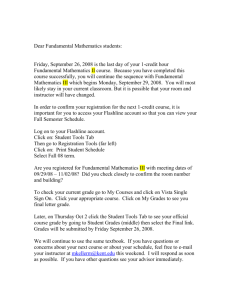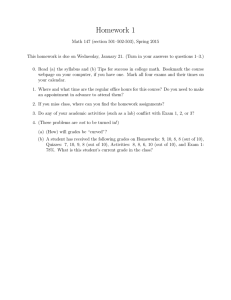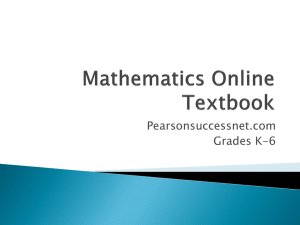English Language Arts and Mathematics AN OVERVIEW FOR PARENTS
advertisement
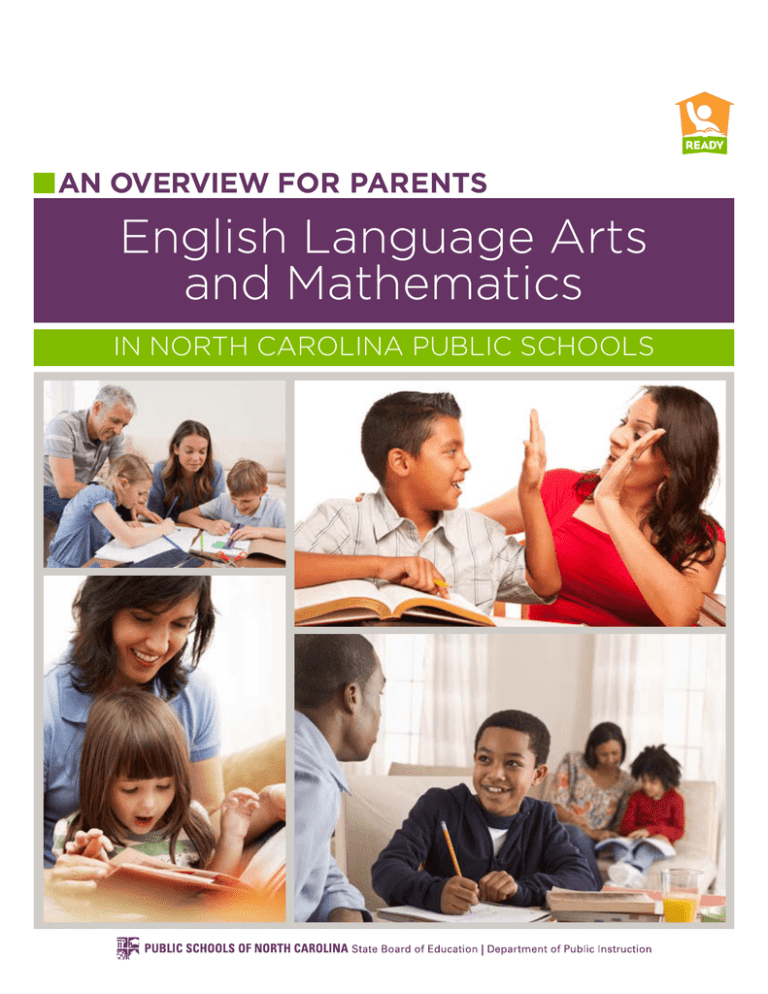
AN OVERVIEW FOR PARENTS English Language Arts and Mathematics IN NORTH CAROLINA PUBLIC SCHOOLS What will my child learn at school? That’s an important question for parents, especially related to English language arts and mathematics, the two key subjects that make learning possible in so many other areas. In North Carolina public schools, teachers are guided by a Standard Course of Study. This provides the standards that all students should reach in each grade or high school course. The Standard Course of Study has been a part of North Carolina’s commitment to students since the early 20th century, and it is updated on a regular basis to make sure it meets the needs of today’s students. In 2010, North Carolina’s State Board of Education voted to use the Common Core State Standards as the state’s English language arts and mathematics standards. The new standards include the key knowledge and skills that all students are expected to learn at each grade. The new standards do not tell teachers exactly how to get students to meet the standards. This is important so that teachers have flexibility to make local choices about how fast they cover material, reading selections, student assignments, textbooks and other tools that will help students develop their skills and knowledge. While all students are expected to meet the standards, there can be many different routes to get there. Elementary Grades (K-5) The earliest grades set a foundation for your student to be successful. The goals for the early grades are to set a strong foundation of reading, writing and math skills, routines and practices so that students can build on this as they move through the higher grades. During these early grades, it is very critical that teachers and parents work together to notice any special learning difficulties or unusual strengths that students may have. The study of language arts at the elementary level includes reading, writing, speaking and listening. Language arts expectations are established for each grade across all subjects including science, history, social studies and arts. Informational texts include literary nonfiction and historical, scientific and technical texts. Teachers and local school districts make their own selections about reading assignments for students. There is no required list of specific reading choices, and these may vary among teachers, schools and districts. One old tried-and-true skill – cursive handwriting – continues to be taught in these early grades. The standards are a road map for learning. Teachers can guide students along different routes to their destination, but the key goal is to reach the standards, or the destination, in this example. This document contains an overview of the new standards for grade spans, kindergarten through Grade 3, Grades 4-5, middle school and high school. Also provided are links to online resources if you want more detail. As parents, you are probably eager to understand what your child will learn each year and how you can support their learning. This document is a starting point. Your child’s teachers and principals can provide even more detail about how they will use the Standard Course of Study in their schools and classrooms with your child. Common Core State Standards – A complete listing and explanation of the Common Core State Standards can be found at http://www.ncpublicschools.org/core-explained/ Following are some examples of the new elementary ELA standards: KINDERGARTEN GRADE 3 • Ask and answer questions about key details in a text. • Determine the main ideas and supporting details of a text read aloud or information presented in diverse media and formats, including visually, quantitatively and orally. • With guidance and support from adults, respond to questions and suggestions from peers and add details to strengthen writing as needed. • Describe familiar people, places, things and events and, with prompting and support, provide additional detail. GRADE 1 • Identify words and phrases in stories or poems that suggest feelings or appeal to the senses. • Participate in collaborative conversations with diverse partners about Grade 1 topics and texts with peers and adults in small and larger groups. • Demonstrate command of the conventions of standard English grammar and usage when writing or speaking. GRADE 2 • Ask and answer such questions as who, what, where, when, why and how to demonstrate understanding of key details in a text. • Write informative/explanatory texts in which the student introduces a topic, uses facts and definitions to develop points and provides a concluding statement or section. • Tell a story or recount an experience with appropriate facts and relevant, descriptive details, speaking audibly in coherent sentences. • With guidance and support from adults, produce writing in which the development and organization are appropriate to task and purpose. • Create engaging audio recordings of stories or poems that demonstrate fluid reading at an understandable pace; add visual displays when appropriate to emphasize or enhance certain facts or details. GRADE 4 • Refer to details and examples in a text when explaining what the text says explicitly and when drawing inferences from the text. • Explain how an author uses reasons and evidence to support particular points in a text. • Demonstrate command of the conventions of standard English grammar and usage when writing or speaking. GRADE 5 • Quote accurately from a text when explaining what the text says explicitly and when drawing inferences from the text. • Read with sufficient accuracy and fluency to support comprehension. • Write opinion pieces on topics or texts, supporting a point of view with reasons and information. For elementary mathematics, the new standards are designed to get students used to the idea of paying close attention to pattern and structure in problems, and to establish good math habits, such as problem solving, persistence, precision, use of solid procedures and checking to see if the answer makes sense. Following are some examples of the broad areas of the new math standards in the elementary grades: KINDERGARTEN GRADE 3 • Know number names and the count sequence. • Understand addition and understand subtraction. • Represent and solve problems involving multiplication and division. • Describe and compare measurable attributes. • Multiply and divide within 100. GRADE 1 • Develop understanding of fractions as numbers. • Represent and solve problems involving addition and subtraction. GRADE 4 • Use place value understanding and properties of operations to add and subtract. • Extend understanding of fraction equivalence and ordering. • Generate and analyze patterns. • Measure lengths indirectly and by iterating length units. • Draw and identify lines and angles and classify shapes by properties of their lines and angles. GRADE 2 GRADE 5 • Work with equal groups of objects to gain foundations for multiplication. • Perform operations with multi-digit whole numbers and with decimals to hundredths. • Work with time and money. • Geometric measurement: understand concepts of volume. • Reason with shapes and their attributes. • Graph points on the coordinate plane to solve real-world and mathematical problems. Middle School (Grades 6-8) Writing is a major focus for the new language arts standards under the Common Core. Most of today’s middle and high school students focus on narrative writing, which is writing about opinions, beliefs and personal experiences. In college or the workplace, however, most writing focuses on informing and explaining. So, the standards have expanded to emphasize writing to inform and explain and writing arguments to support claims in addition to narrative writing. Examples of middle school standards in ELA are as follows: GRADE 6 • Compare and contrast texts in different forms or genres (e.g., stories and poems; historical novels and fantasy stories) in terms of their approaches to similar themes and topics. • Write informative/explanatory texts to examine a topic and convey ideas, concepts and information through the selection, organization and analysis of relevant content. • Write narratives to develop real or imagined experiences or events using effective technique, relevant descriptive details and well-structured event sequences. GRADE 7 • Introduce a topic clearly, previewing what is to follow; organize ideas, concepts and information, using strategies such as definition, classification, comparison/contrast and cause/effect; include formatting (e.g., headings), graphics (e.g., charts, tables), and multimedia when useful to aiding comprehension. • Compare and contrast a written story, drama or poem to its audio, filmed, staged or multimedia version, analyzing the effects of techniques unique to each medium (e.g., lighting, sound, color or camera focus and angles in a film). • Determine or clarify the meaning of unknown and multiplemeaning words and phrases based on grade 7 reading and content, choosing flexibly from a range of strategies. GRADE 8 • Write over extended time frames (time for research, reflection and revision) and shorter time frames (a single sitting or a day or two) for a range of discipline-specific tasks, purposes and audiences. • Conduct short research projects to answer a question (including a self-generated question), drawing on several sources and generating additional related, focused questions that allow for multiple avenues of exploration. • By the end of the year, read and comprehend literature, including stories, dramas and poems, at the high end of Grades 6-8 text complexity band independently and proficiently. Mathematics in middle school will prepare students to be ready for Algebra by the eighth grade. Following are some examples of the broad areas of the new math standards in the middle school grades: GRADE 6 • Apply and extend previous understandings of numbers to the system of rational numbers. • Apply and extend previous understandings of arithmetic to algebraic expressions. • Develop understanding of statistical variability. GRADE 7 • Analyze proportional relationships and use them to solve real-world and mathematical problems. • Use properties of operations to generate equivalent expressions. • Solve real-life and mathematical problems involving angle measure, area, surface area and volume. GRADE 8 • Know that there are numbers that are not rational, and approximate them by rational numbers. • Define, evaluate and compare functions. • Investigate patterns of association in bivariate data. High School (Grades 9-12) Language arts expectations are established for each grade across all subjects including science, history, social studies and technical subjects. Vocabulary words such as lava, carburetor, legislature, circumference and aorta are just a few examples of how language arts expectations can have an impact on a variety of academic subjects. As in middle school, high schools students’ expectations are higher under the Common Core, with a heavy emphasis on writing and analysis of text. Under the new standards, students might be asked to: • Read an interview with a teenager who started a charity to help Peruvian orphans; • Learn more about other young people who devote themselves to helping those in need through additional articles/videos; • Answer questions that require them to describe what they’ve learned, citing evidence from articles and videos; and, • Research, write and present a five-minute speech about one of these young people. For mathematics in high school, a deeper look at different ways to solve problems is part of the new standards. In fact, the mathematics Standard Course of Study goes beyond the Common Core and includes more advanced topics such as Advanced Functions and Modeling. Functions describe situations where one quantity determines another, such as return on an investment or the time it takes a car to drive a certain number of miles. Modeling is the process of choosing and using appropriate mathematics and statistics to analyze empirical situations, to understand them better and to improve decisions Students will need to accurately calculate equations, understand concepts not just memorize answers, and accurately select the best mathematical concept or equation to solve real-world problems. There is a focus on demonstrating why a specific method or equation is accurate. Resources For Parents This packet was designed as a broad overview of the new Common Core State Standards and what they mean for North Carolina public school students. The NCDPI strongly encourages parents to spend some time learning more about the new standards in detail. Below are some resources about the Common Core State Standards: COMMON CORE EXPLAINED n explanation of the new standards, a complete listing of the new standards A and Frequently Asked Questions, http://www.ncpublicschools.org/core-explained/ NORTH CAROLINA PTA http://ncpta.org/index.php/programs/parent-involvement/common-core-state-standards/ NBC EDUCATION NATION PARENT TOOLKIT http://www.parenttoolkit.com F OUNDATION FOR EXCELLENCE IN EDUCATION – COMMON CORE STATE STANDARDS http://excelined.org/common-core-toolkit/ GRADUATION REQUIREMENTS www.ncpublicschools.org/gradrequirements/ K-12 STANDARDS IN SCIENCE AND OTHER SUBJECTS www.ncpublicschools.org/acre/standards/ STATE TEST RESULTS FOR STUDENTS www.ncpublicschools.org/accountability/ N.C. SCHOOL REPORT CARDS www.ncreportcards.org/ In compliance with federal law, the NC Department of Public Instruction administers all state-operated educational programs, employment activities and admissions without discrimination because of race, religion, national or ethnic origin, color, age, military service, disability, or gender, except where exemption is appropriate and allowed by law. Inquiries or complaints regarding discrimination issues should be directed to: Dr. Rebecca Garland, Chief Academic Officer :: Academic Services and Instructional Support 6368 Mail Service Center, Raleigh, NC 27699-6368 :: Phone: (919) 807-3200 :: Fax: (919) 807-4065 Visit us on the Web :: www.ncpublicschools.org
